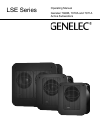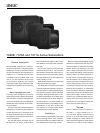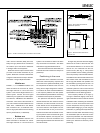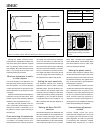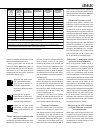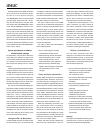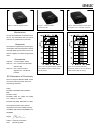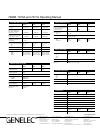
system it is necessary to temporarily connect
either of the channels to this output.
Power up the system and set the DIP
switches 3 (SUM IN MODE) and 4 (LFE +10
dB) on the first switch group to "ON" Now you
should hear an 85 Hz test signal from the
subwoofer and the main monitor connected
to the center channel output.
Toggle the -180° phase switch
(DIP 4 on the second switch
group) on and off, and set it to
the position which gives the
lowest sound level at the listen-
ing position.
Next toggle the -90° phase
switch (DIP 3) on and off, and
again set it to the position which
gives the lowest sound level.
Finally, set the -180° phase
switch (DIP 4) to the opposite
setting and deactivate the test
signal.
Phase correction method with
test equipment
The following procedure matches the phase
between the subwoofer and the main moni-
Table 2. Recommended subwoofer/main monitor combinations.
tors using a frequency analyser and a pink
noise generator. Connect a high grade
measuring microphone to the analyser and
feed pink noise into the "CENTER IN" input
of the subwoofer. The subwoofer's bass
management system will direct the frequen-
cies above 85 Hz to the center main monitor
while the subwoofer reproduces the frequen-
cies below 85 Hz.
Position the microphone at the listening
position and adjust the input sensitivity of
the subwoofer until frequencies below and
above 85 Hz are reproduced at equal level.
Then adjust the phase control switches for
the maximum dip of at least -6 dB at the
crossover frequency (85 Hz).
Change the -180° switch to the opposite
setting. The phase should now be set cor-
rectly and the frequency analyser should
show a smooth response around 85 Hz.
Overload indicators
The mode indicator LED on the connector
panel will turn from green to yellow to indi-
cate clipping and then to red to indicate that
the protection circuit has activated. If this
occurs frequently, reduce the input level to
the subwoofer until the LED remains green.
If the LED on the connector panel is not
easily visible, the optional Remote LED Kit
can be used to bring it into view. The kit con-
sists of a LED in a compact case and a RJ11
cable to connect the case and the "REMOTE"
RJ11 connector on the connector panel.
Subwoofer bypass control
A bypass control feature is included in the
subwoofer circuits so that the effect of the
subwoofer on the whole monitor system can
be determined. With the bypass switch on,
the high pass filters for the main monitors are
overridden and the system behaves as if the
subwoofer was not connected. The bypass
function has no effect on the LFE input. Two
different bypass remote controllers are avail-
able as optional equipment: 1092-400 switch
that can be connected to a 1/4" jack connec-
tor on the connector panel and 7000-416 that
connects to the "REMOTE" RJ11 connector.
The 7000-416 option also includes remote
control of the "LFE +10 dB" function and a
link for the 7000-415 remote LED option.
Subwoofer in analogue matrix
surround sound systems.
When using Genelec 7060B, 7070A or
7171A subwoofers in a consumer analogue
matrix surround sound system, such as
Dolby Surround, Dolby Pro-Logic or Pro-
Logic II or a professional matrix decoder
such as a Dolby SDU-4, route the front chan-
nels through the subwoofer so that the output
of the subwoofer is matched to the rest of the
system and select "Large" setting for the
front speakers on the decoder. If there is a
subwoofer channel output on the decoder it
should NOT be connected to the subwoofer's
"LFE IN" input since the processing within an
analogue decoder will conflict with the filter-
ing in the subwoofer. Connecting the rear
channels to the subwoofer is optional since
the rear channels from most matrix decoders
are band limited down to 100 Hz.
Monitoring the LFE channel
in digital discrete surround
sound systems
Some digital surround sound systems use
a discrete Low Frequency Effects channel
which should be connected to the "LFE IN"
input on the connector panel. This enables
the subwoofer to correctly reproduce all the
bass information in the mix.
Maximum
room
volume,
m
3
(ft
3
)
Maximum
listening
distance,
m (ft)
Front
loudspeakers
Stereo & LCR
Side and rear
loudspeakers
Subwoofers
for
2-channel
Stereo
Subwoofers
for 5-channel
Surround
75 (2,600) 2.0m (6’7”) 8030A 8030A 7050B 7060A
75 (2,600) 2.0m (6’7”) 8130A 8130A 7050B 7060A
(1)
85 (3,000) 2.2m (7’3”) 8040A 8040A 7060B 7070A
95 (3,400) 2.3m (7’7”) 8050A 8050A 7070A 7070A
110 (3,900) 2.4m (7’10”) 1032A 1032A 7070A 7071A
125 (4,400) 3.5m (11’6”) 1037C 1037C 7071A 2x7071A
170 (6,000) 4.0m (13’1”) 1038B & 1038BC 1038B 7071A 2x7071A
200 (7,000) 4.5m (14’9”) 1034B & 1034BC 1038B 7071A 2x7071A
(2)
240 (8,500) 4.7m (15’5”) 1039A 1038B 2x7071A 2x7071A
(2)
400 (14,000) 5.5m (18’1”) 1035B 1038B 2x7071A
(2)
3x7071A
(2)
400 (14,000) 5.5m (18’1”) 1036A 1038B
(3) (3)
(1)
When using a digital input signal, the 8130A cannot be used with the subwoofer’s analogue crossover
filters. The subwoofer can be used for reproducing the LFE channel only.
(2)
Additional subwoofers of the same type may be required in a larger room with bass heavy program material.
(3)
Subwoofers are not necessarily required for a 1036A installation as these monitors are already full range.
For surround systems, subwoofers can be used to reproduce the LFE channel.



